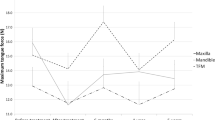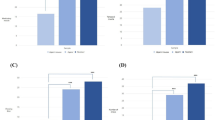Abstract
Background
Masticatory performance of elderly complete denture wearers is low, which may lead to restriction on intakes of several foods such as fresh fruit or raw vegetables.
Aim
The aim of this study was to investigate the relationship between tongue motor function, lip motor function, and mixing ability in complete denture wearers.
Materials and methods
Participants comprised 54 complete denture wearers with a mean age of 77.1 years. Maximum tongue pressure and oral diadochokinesis were measured to evaluate tongue and lip motor functions. A color-changeable, chewing gum was used to evaluate mixing ability. The relationship between tongue and lip motor functions and mixing ability was assessed using stepwise multiple regression analysis.
Results
The stepwise multiple regression analysis identified maximum tongue pressure, the number of repetitions of the syllable “ka”, and gender as significant predictors for mixing ability among complete denture wearers.
Discussion
The elderly edentulous individuals mainly used tongue motor function in oral motor functions for mixing color-changeable chewing gums, which might be ascribable to wearing complete dentures.
Conclusions
Under the limited conditions of this study, factors relating to tongue motor function, tongue pressure and the number of repetitions of the syllable “/ka”/ significantly contributed to the mixing ability of complete denture wearers. It was suggested that tongue motor function had positive effect on the mixing ability of complete denture wearers.
Similar content being viewed by others
References
Mojon P, Thomason JM, Walls AW (2004) The impact of falling rates of edentulism. Int J Prosthodont 17:434–440
Thomason JM, Kelly SA, Bendkowski A et al (2012) Two implant retained overdentures—a review of the literature supporting the McGill and York consensus statements. J Dent 40:22–34
Slagter AP, Bosman F, Van der Bilt A (1993) Comminution of two artificial test foods by dentate and edentulous subjects. J Oral Rehabil 20:159–176
Mishellany-Dutour A, Renaud J, Peyron MA et al (2008) Is the goal of mastication reached in young dentates, aged dentates and aged denture wearers? Br J Nutr 99:121–128
Veyrune JL, Lassauzay C, Nicolas E et al (2007) Mastication of model products in complete denture wearers. Arch Oral Biol 52:1180–1185
Van der Bilt A (2011) Assessment of mastication with implications for oral rehabilitation: a review. J Oral Rehabil 38:754–780
De Marchi RJ et al (2011) Edentulism, use of dentures and consumption of fruit and vegetables in south Brazilian community-dwelling elderly. J Oral Rehabil 38:533–540
Wakai K, Naito M, Naito T et al (2010) Tooth loss and intakes of nutrients and foods: a nationwide survey of Japanese dentists. Community Dent Oral Epidemiol 38:43–49
Baum BJ, Bodner L (1983) Aging and tongue and lips functions: evidence for altered performance among older persons. J Dent Res 62:2–6
Kikutani T, Tamura F, Nishiwaki K et al (2009) Oral motor functions and masticatory performance in the community-dwelling elderly. Odontology 97:38–42
Tanaka T, Takahashi K, Hirano H et al (2017) Oral frailty as a risk factor for physical frailty and mortality in community-dwelling elderly. J Gerontol A Biol Sci Med Sci. https://doi.org/10.1093/gerona/glx25
Minakuchi S, Tsuga K, Ikebe K et al (2018) Oral hypofunction in the older population: position paper of the Japanese Society of Gerodontology in 2016. Gerodontology. https://doi.org/10.1111/ger.12347
Kapur KK, Soman SD (1964) Masticatory performance and efficiency in denture wearers. J Prosthet Dent 14:687–694
Olthoff LW, Van der Bilt A, Bosman F, Kleizen HH (1984) Distribution of particle sizes in food comminuted by human mastication. Arch Oral Biol 29:899–903
Okiyama S, Ikebe K, Nokubi T (2003) Association between masticatory performance and maximal occlusal force in young men. J Oral Rehabil 30:278–282
Ikebe K, Morii K, Matsuda K et al (2005) Reproducibility and accuracy in measuring masticatory performance using test gummy jelly. Prosthodont Res Pract 4:9–15
Takahashi M, Koide K, Arakawa I et al (2013) Association between perioral muscle pressure and masticatory performance. J Oral Rehabil 40:909–915
Ikebe K, Matsuda K, Kagawa R et al (2011) Association of masticatory performance with age, gender, number of teeth, occlusal force and salivary flow in Japanese older adults: is ageing a risk factor for masticatory dysfunction? Arch Oral Biol 56:991–996
Shiga H, Kobayashi Y, Arakawa I et al (2006) Validation of a portable blood glucose testing device in measuring masticatory performance. Prosthodont Res Pract 5:15–20
Okiyama S, Yoshida M, Yamamoto M et al (1996) Influence of physical properties of testing food and occlusal contact on masticatory efficiency. J Jpn Prosthodont Soc 40:710–717 (in Japanese)
Van der Bilt A, Fontijn-Tekamp FA (2004) Comparison of single and multiple sieve methods for the determination of masticatory performance. Arch Oral Biol 49:193–198
Escudeiro-Santos C, Freitas O, Spadaro ACC et al (2006) Development of a colorimetric system for evaluation of the masticatory efficiency. Braz Dent J 17:95–99
Yoshida E, Fueki K, Igarashi Y (2007) Association between food mixing ability and mandibular movements during chewing of a wax cube. J Oral Rehabil 34:791–799
Sugiura T, Fueki K, Igarashi Y (2009) Comparisons between a mixing ability test and masticatory performance tests using a brittle or an elastic test food. J Oral Rehabil 36:159–167
Salleh NM, Fueki K, Garrett NR et al (2007) Objective and subjective hardness of a test item used for evaluating food mixing ability. J Oral Rehabil 34:174–183
Hayakawa I, Watanabe I, Hirano S et al (1998) A simple method for evaluating masticatory performance using a color-changeable chewing gum. Int J Prosthodont 11:173–176
Yamada A, Kanazawa M, Komagamine Y et al (2015) Association between tongue and lip functions and masticatory performance in young dentate adults. J Oral Rehabil 42:833–839
Hama Y, Hosoda A, Komagamine Y et al (2017) Masticatory performance-related factors in preschool children: establishing a method to assess masticatory performance in preschool children using colour-changeable chewing gum. J Oral Rehabil. https://doi.org/10.1111/joor.12553
Koshino H, Hirai T, Ishijima T et al (1997) Tongue motor skills and masticatory performance in adult dentates, elderly dentates, and complete denture wearers. J Prosthet Dent 77:147–152
Tsuga K, Maruyama M, Yoshikawa M et al (2011) Manometric evaluation of oral function with a hand-held balloon probe. J Oral Rehabil 38:680–685
Ito K, Yoshihara A, Takano N et al (2009) A comparison of methods for the measurement of oral diadochokinesis. Jpn J Gerodontol 24:48–54 (in Japanese)
Ziegler W (2002) Task-related factors in oral motor control: speech and oral diadochokinesis in dysarthria and apraxia of speech. Brain Lang 80:556–575
Hickey JC, Zarb GA, Bolender CL (1975) Boucher’s prosthodontic treatment for edentulous patients. 7th edn. St. Louis, Mosby
Sheppard JM (1963) Denture base dislodgment during mastication. J Prosthet Dent 13:462–468
Fish SF. Adaptation and habituation to full dentures. Br Dent J 127:19–26
Brill N, Tryde G, Schubeler S (1960) The role of learning in denture retention. J Prosthet Dent 10:468–475
Baum BJ, Bodner L (1983) Aging and oral motor function: evidence for altered performance among older persons. J Dent Res 62:2–6
Morita K, Tsuka H, Kato K, Mori T, Nishimura R, Yoshida M, Tsuga K (2018) Factors related to masticatory performance in healthy elderly individuals. J Prosthodont Res. https://doi.org/10.1016/j.jpor.2018.03.007
Limpuangthip N, Somkotra T, Arksornnukit M (2017) Modified retention and stability criteria for complete denture wearers: a risk assessment tool for impaired masticatory ability and oral health-related quality of life. J Prosthet Dent. https://doi.org/10.1016/j.prosdent.2017.09.010
Komagamine Y, Kanazawa M, Minakuchi S, Uchida T, Sasaki Y (2011) Association between masticatory performance using a colour-changeable chewing gum and jaw movement. J Oral Rehabil 38:555–563
Horie T, Kanazawa M, Komagamine Y, Hama Y, Minakuchi S (2014) Association between near occlusal contact areas and mixing ability. J Oral Rehabil 41:829–835
Kubota C, Kanazawa M, Hama Y, Komagamine Y, Minakuchi S (2017) Association between chewing-stimulated salivary flow under the effects of atropine and mixing ability assessed using a color-changeable chewing gum. J Prosthodont Res 61:387–392
Van der Bilt A, Mojet J, Tekamp FA, Abbink JH (2010) Comparing masticatory performance and mixing ability. J Oral Rehabil 37:79–84
Speksnijder CM, Abbink JH, van der Glas HW, Janssen NG, Van der Bilt A (2009) Mixing ability test compared with a comminution test in persons with normal and compromised masticatory performance. Eur J Oral Sci 117:580–586
Hama Y, Kanazawa M, Minakuchi S, Uchida T, Sasaki Y (2014) Properties of a color-changeable chewing gum used to evaluate masticatory performance. J Prosthodont Res 58:102–106
Hama Y, Kanazawa M, Minakuchi S, Uchida T, Sasaki Y (2014) Reliability and validity of a quantitative color scale to evaluate masticatory performance using color-changeable chewing gum. J Med Dent Sci 61:1–6
Acknowledgements
This research did not receive any specific grant from funding agencies in the public, commercial, or non-profit sectors.
Funding
No funding.
Author information
Authors and Affiliations
Corresponding author
Ethics declarations
Conflict of interest
On behalf of all authors, the corresponding author, Manabu Kanazawa states that there is no conflict of interest.
Ethical approval
All procedures performed in studies involving human participants were in accordance with the ethical standards of the institutional and/or national research committee and with the 1964 Helsinki declaration and its later amendments or comparable ethical standards.
Informed consent
Informed consent was obtained from all individual participants included in the study.
Rights and permissions
About this article
Cite this article
Komagamine, Y., Kanazawa, M., Yamada, A. et al. Association between tongue and lip motor functions and mixing ability in complete denture wearers. Aging Clin Exp Res 31, 1243–1248 (2019). https://doi.org/10.1007/s40520-018-1070-2
Received:
Accepted:
Published:
Issue Date:
DOI: https://doi.org/10.1007/s40520-018-1070-2




